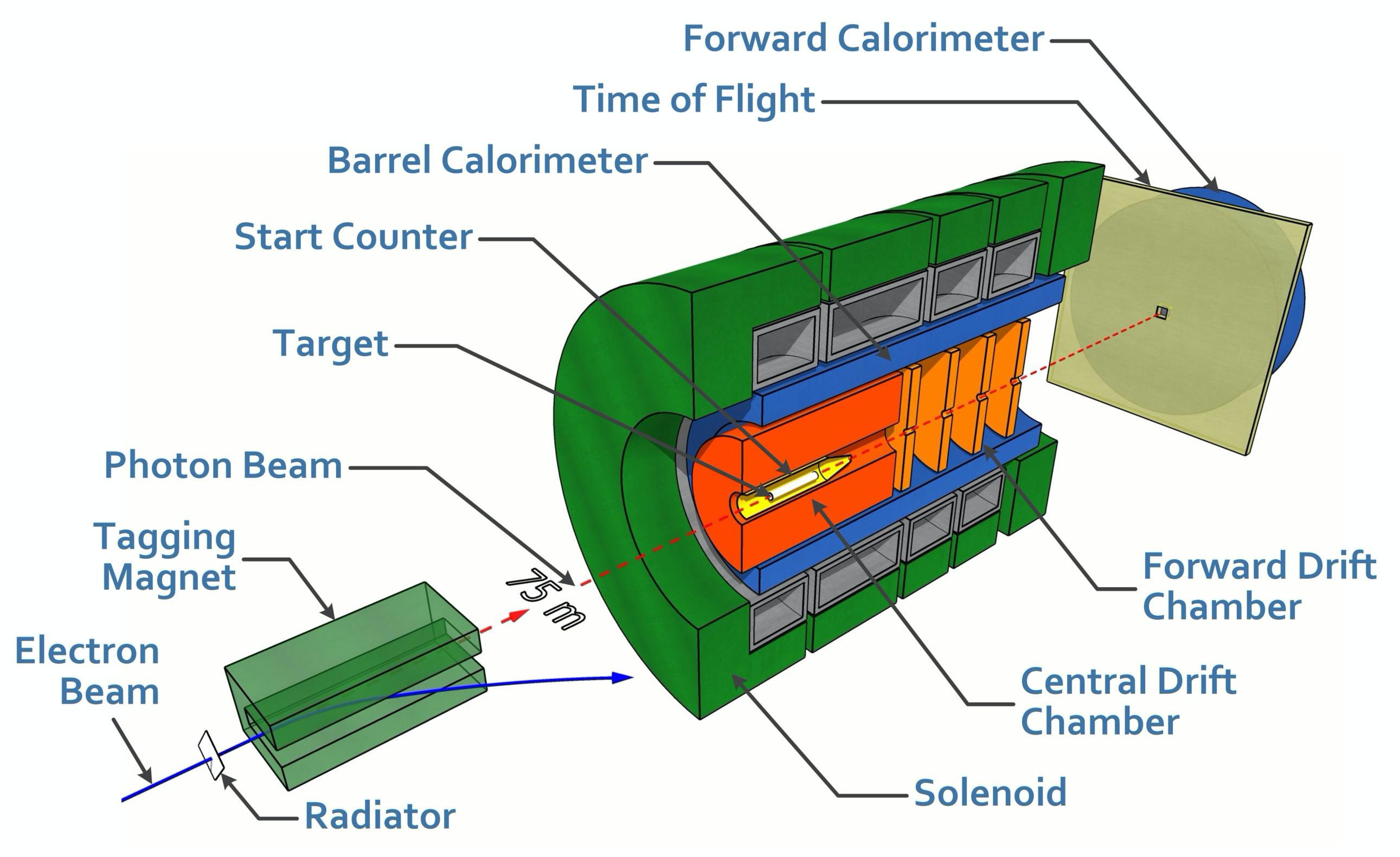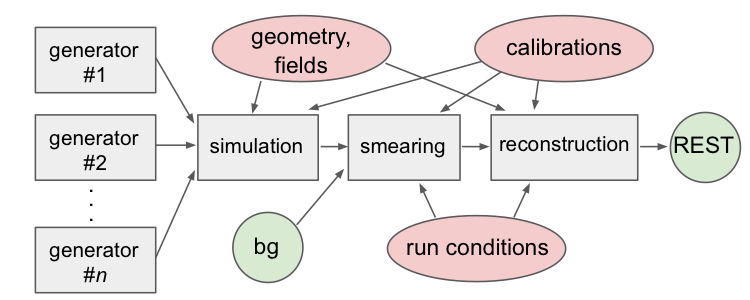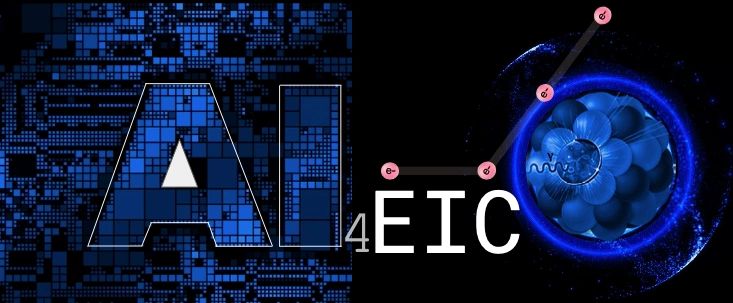Introduction to GlueX#
Scientific Motivation#
The GlueX experiment is a dedicated photoproduction experiment at Jefferson Lab (Hall D), designed to explore the spectrum of light-quark mesons, with special sensitivity to hybrid and exotic mesons that carry gluonic excitations beyond the simple quark–antiquark picture. [1, 2]
Lattice QCD and phenomenological models predict that hybrid mesons with exotic quantum numbers (for example \(J^{PC} = 1^{-+}, 0^{+-}, 2^{+-}\)) should exist in the light-quark sector. These states are difficult to access in many production modes but may be favorable in photoproduction at intermediate energies. [1, 2, 3]
GlueX aims to provide a high-statistics, high-acceptance data set with linearly polarized photons to enable precision spectroscopy and amplitude analyses. [1, 2]
Experimental Apparatus and Beamline#
CEBAF and Hall D#
The Continuous Electron Beam Accelerator Facility (CEBAF) at JLab delivers up to 12 GeV electron beams, which feed into multiple experimental halls. The Hall D complex was added as part of the 12 GeV upgrade to house the GlueX experiment. [1, 4]
Photon Beam Production and Tagging#
To create a linearly polarized photon beam near 9 GeV, GlueX uses coherent bremsstrahlung from a thin diamond radiator. Electrons that emit photons lose energy and are bent more strongly by downstream dipoles; their position in the tagging spectrometer determines the photon energy. The polarization is maximized near a coherent peak in the spectrum. [1, 4]
Photon flux is monitored via a pair spectrometer, and polarization is measured by a triplet polarimeter. [4]
Target and Trigger#
The photon beam interacts with a liquid hydrogen target (30 cm long) inside the spectrometer. Downstream detectors form triggers based on multiplicities, energy deposits, and timing. The DAQ system supports high trigger rates (tens of kHz) and uses pipelined electronics (flash ADCs, TDCs) with ~3.3 µs latency. [4]
Detector Systems Overview#
Below is a simplified schematic of the GlueX detector in Hall D:

Fig. 1 Cut-away view of GlueX in Hall D (not to scale).#
The detector is azimuthally symmetric and nearly hermetic for charged and neutral particles. [4]
Major subsystems:
Tracking detectors
Central Drift Chamber (CDC / straw tubes)
Forward Drift Chambers (FDC) (planar wire & cathode strips)
Time of Flight (TOF) system
Start counter (SC)
Barrel Calorimeter (BCAL) – The Barrel Calorimeter (BCAL), built with layers of scintillating fibers and lead, surrounds the tracking region. Its design allows coverage for photons over a large polar angle range. It was commissioned in 2014 and operates routinely. Performance includes: \( \frac{\sigma_E}{E} \approx \frac{5.2\%}{\sqrt{E}} \oplus 3.6\% \), timing resolution ~150 ps at 1 GeV. [5]
Forward Calorimeter – The forward calorimeter uses lead-glass modules arranged in a matrix to detect forward-going photons. (We will use FCAL data in later tutorial sections.)
Particle Identification – In early GlueX running (Phase I) the PID was based on \(\frac{dE}{dx}\) and TOF. In the Phase II program, a DIRC (Detection of Internally Reflected Cherenkov light) system (recycled from BaBar) was installed to enhance kaon/pion (\(K/\pi\)) discrimination, especially in the forward direction [5, 6].
Data Taking, Simulation, and Reconstruction Software#
Run Periods and Beam Conditions#
GlueX began commissioning in 2014, then gradually ramped to physics-quality data in 2016 and beyond. The approved Phase I program ran through 2018, collecting large data sets. Phase II is ongoing, featuring the DIRC upgrade and higher photon fluxes. [1, 7]
Photon flux in Phase I ranged from \(1\times10^{7}\) to \(3\times 10^{7} \gamma/s\) in the coherent peak. [7]
Simulation Framework#
GlueX uses a GEANT4-based simulation (HDGeant4) to model detector response, geometry, and materials. Digitization and smearing steps generate simulated detector hits. Conditions (e.g. calibration constants) are pulled from databases (CCDB, RCDB). [4, 8]
Reconstruction and Analysis Workflow#
The data and MC are processed through halld_recon, using JANA2 (JANA) as the event engine. Reconstruction includes:
Hit clustering, track finding, and fitting
Shower and cluster association
Kinematic fitting, vertexing, and particle ID
Skim and reduction to analysis-level ntuples
Reaction factories / amplitude analysis
The JANA/DANA framework enables modular plugins for physics skims and format conversion.

Fig. 2 Flow chart on simulation and reconstruction pipeline used at GlueX.#
References#
GlueX Collaboration / Hall-D Wiki. Overview of the gluex experiment. Online, 2025. URL: https://halldweb.jlab.org/wiki/index.php/GlueX_Project_Overviews.
J. Zarling. The gluex experiment: recent results and future plans. JPS Conference Proceedings, 2019. arXiv:1911.11239.
E. S. Swanson. The new resonances: exotic or conventional mesons? Physics Reports, 429:243, 2006.
GlueX Collaboration and others. The gluex beamline and detector. Nuclear Instruments and Methods A 987, pages 164807, 2021. arXiv:2005.14272.
T. Beattie and others. Construction and performance of the barrel electromagnetic calorimeter for the gluex experiment. arXiv (Few-Body Systems), 2018. arXiv:1801.03088.
A. Ali and others. Installation and commissioning of the gluex dirc. arXiv, 2020. arXiv:2005.07195.
GlueX Collaboration. Future physics using gluex in hall-d. GlueX White Paper, 2019. halldweb whitepaper.
GlueX Collaboration / Hall-D Wiki. Gluex / hall-d online documentation. Online, 2025. URL: https://halldweb.jlab.org/wiki.
